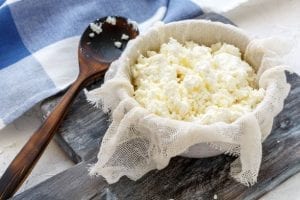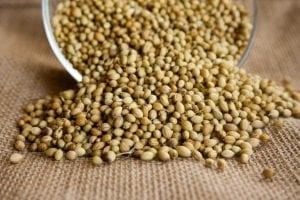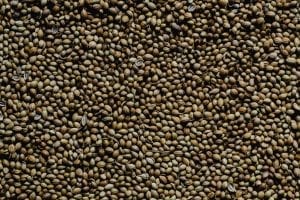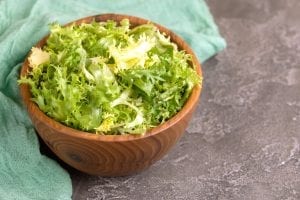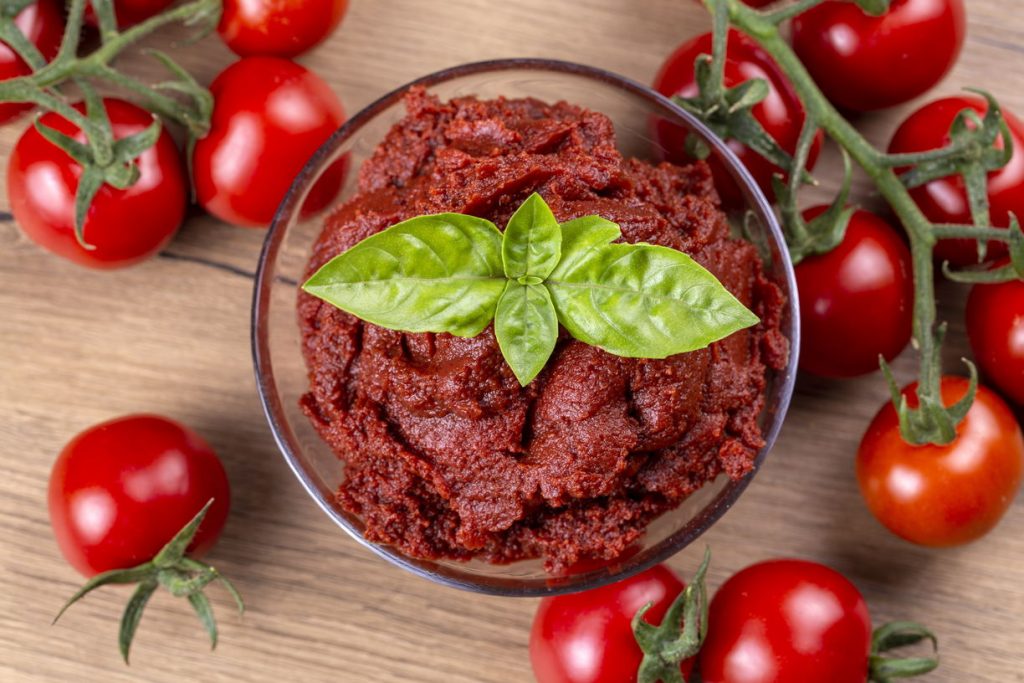
You put your cooking hat on, ready to make the best marinara sauce using a not-so-secret ingredient — tomato paste! Only, you realize that you’ve run out of this condiment in your kitchen. Well, fret not! Because we’ll share with you the best tomato paste substitute options that you can use instead. You no longer have to rush to the nearby supermarket or grocery store every time you run out of this pantry staple.
What Is Tomato Paste?
First, let’s talk about what tomato paste is. This staple ingredient is the tasty outcome of simmering fresh tomatoes for several hours, effectively removing most of the vegetable’s water content. As a result, you get concentrated tomatoes that have a thick, paste-like consistency. Reducing tomatoes into a paste gives them a deep flavor that tastes almost meaty.
Tomato paste mainly acts as a thickening agent for pasta sauces and soups. And on top of that, it also adds color and flavor to savory dishes, just like in this Irish beef stew.
8 Handy Substitutes for Tomato Paste
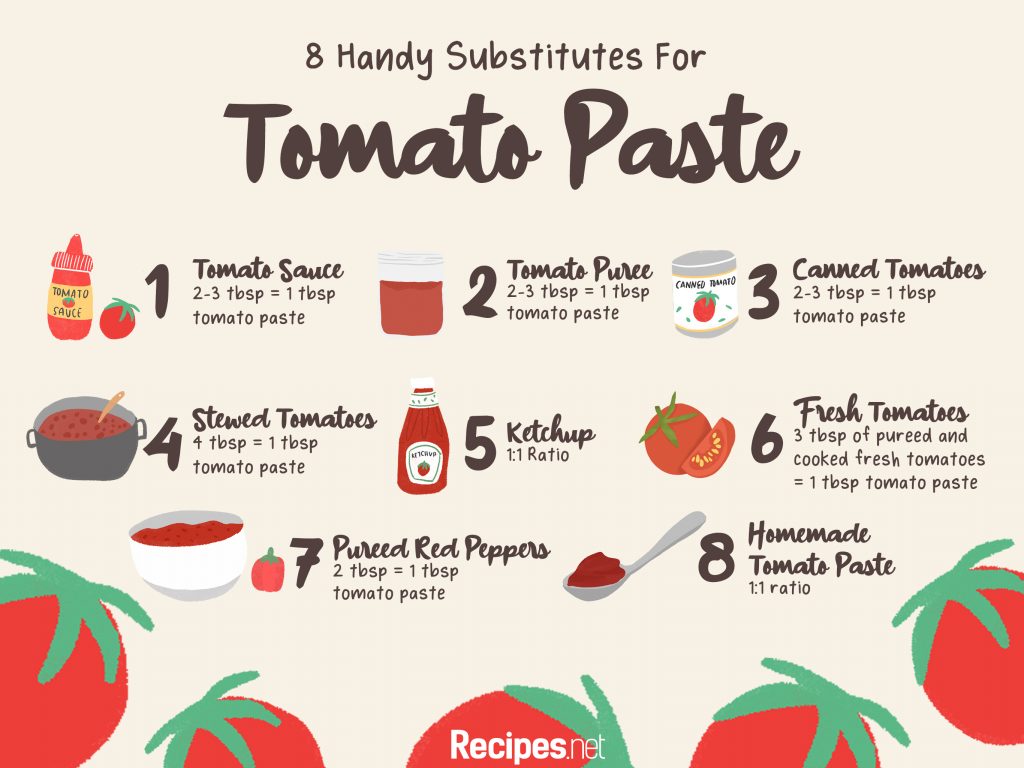
This tomato condiment is very common in canned food aisles at grocery stores. Aside from being available in tins, tomato paste also comes in tubes. Using a tiny amount of this thickening foodstuff is enough to get the consistency you want. Considering you don’t really need a lot of it in most recipes, one container is ample to last you a while.
Now, chances are you’ll soon forget about that half-opened can of tomato paste in your fridge. And when you finally need it, it’s already gone to waste.
So what’s a great substitute for tomato paste then? If you’re planning to whip up a yummy sloppy joes recipe and you don’t have tomato paste on hand, then consider these eight best replacements.
Tomato Sauce
When it comes to the whole debate on tomato sauce vs tomato paste, the former is much thinner and less concentrated than the latter. You can substitute tomato sauce for tomato paste in dishes that are slightly watery like soups and stews. You can use this as a tomato paste substitute for pizza as long as you use the plain kind. It’s the best swap as it is the closest in flavor.
However, if you desire a more viscous consistency for your dishes, you can thicken tomato sauce beforehand. Simply simmer the sauce on the stovetop, on a gentle heat until it resembles the texture of tomato paste. Reduced tomato sauce also works great as a tomato paste substitute for a shepherd’s pie recipe for added sweetness and color.
Now, when using this as a substitute, remember that two to three tablespoons of tomato sauce is equivalent to a tablespoon of tomato paste. That’s enough to lend a tomato flavor to soups or pasta sauces.
READ ALSO: 11 Substitutes for Tomato Sauce You Can Use
Tomato Puree
This substitute is essentially boiled, strained, and blended tomatoes. As it is cooked, it has a more developed flavor and slightly thicker consistency compared to tomato sauce. This makes it a suitable substitute for tomato paste and works better when reduced further.
For a thicker texture and richer taste like tomato paste, reduce the puree on medium-low heat for around 10 minutes until it reaches the desired viscosity. Stir frequently to avoid burning the bottom of your saucepan. It is best as a tomato paste replacement for stews and sauces. Using two to three tablespoons of puree for every tablespoon of tomato paste is the recommended substitution ratio.
Note
Alternatively, you can also use passata if you have it on hand. It is essentially an Italian version of tomato puree that is uncooked and slightly thicker. The same measurements for substituting tomato puree for tomato paste also apply to passata.
Canned Tomatoes
When you want to make your tasty spaghetti sauce rich and thick, you can use canned tomatoes in lieu of the paste. Whole, crushed, or diced tomatoes are the types of canned tomatoes you’ll usually find in stores. Regardless of what you have, these tinned tomatoes will typically have more water content. So it would be best to cook it down to thicken. Then, strain the excess liquids and bits so your dish doesn’t become watery and chunky.
Incorporate at least two to three tablespoons of strained canned tomatoes into the recipe that calls for a tablespoon of tomato paste. In that way, your dish will still have that deep tomato flavor.
Stewed Tomatoes
In terms of taste, stewed tomatoes have the same robustness as tomato paste. Though they are similarly simmered, stewed tomatoes are seasoned first. It’s cooked along with other ingredients such as onions, garlic, celery, and even red bell peppers. Thus, is a tastier substitute for tomato paste.
When using stewed tomatoes instead of tomato paste, simmer properly and drain the liquid to avoid watering down the dish. You’ll need four tablespoons of drained stewed tomatoes for every one tablespoon of tomato paste. This makes for a great tomato paste substitute in chili recipes like this buffalo beer chili dish.
Ketchup
Can you use ketchup as a substitute for tomato paste? The answer is yes! Ketchup, though not as thick as the paste, is another incredible substitute you can use. However, using this will yield a slightly different flavor profile. This is because ketchup is bursting with flavors from vinegar, sugar, and spices content.
You can use equal proportions of this substitute to the required tomato paste in your dish. So, if a recipe calls for one tablespoon of tomato paste, one tablespoon of ketchup will suffice. Substitute ketchup for tomato paste in recipes that needs sweetness. It’ll surely work well as a substitute for chili or in this deliciously baked Italian sausage and carrots dish.
Fresh Tomatoes
Now, it’s possible you don’t have packaged tomatoes within reach. Fortunately, you can also use fresh tomatoes to replace tomato paste. If you have a bunch of fresh ones lying around in your kitchen or in your garden, you can also add them to your dish.
But there’s a catch! Using fresh tomatoes in place of tomato paste requires a bit of elbow grease and patience. You’ll need to remove its skin and seeds, cook it down, and strain it to achieve a close approximation to tomato paste.
Preparing this substitute is like making your own tomato puree at home. It works well in curries, soups, or salads. If you don’t mind the effort, cook down the tomatoes for 10 minutes while stirring constantly until it’s almost jammy. Use three tablespoons of pureed and cooked fresh tomatoes for every tablespoon of this tomato paste replacement.
Pureed Red Peppers
Red bell peppers surprisingly make for an incredible tomato paste substitute. Though not a tomato substitute like others on this list, its red color and pepperiness make up for the lack of tomato flavor. If you want a slightly exotic taste, all you have to do is roast the bell peppers, peel off the skin, and extract the seeds. Then, puree them using a food processor or a blender to make them into a paste.
Should you want a thicker finish, you can simmer the pureed red peppers. The result won’t be as thick as tomato paste, but it’ll give just the right amount of body and punch.
Before adding them to recipes with tomato paste, remember the ratio of one tablespoon of red pepper puree for every tablespoon of tomato paste. Substitute tomato paste with pureed red peppers in chili, stews, or in this savory one-pot noodles with beans recipe.
Homemade Tomato Paste
The best substitute for tomato paste is naturally a homemade one. Making your own homemade tomato paste, though labor-intensive, will reward you with a richer and more flavorful counterpart. Most of all you get to avoid additives or preservatives that come with canned or tubed tomato paste, making it a healthy option.
If you don’t mind the hassle of making your own DIY homemade tomato paste, check out our how-to guide below.
How to Make Tomato Paste
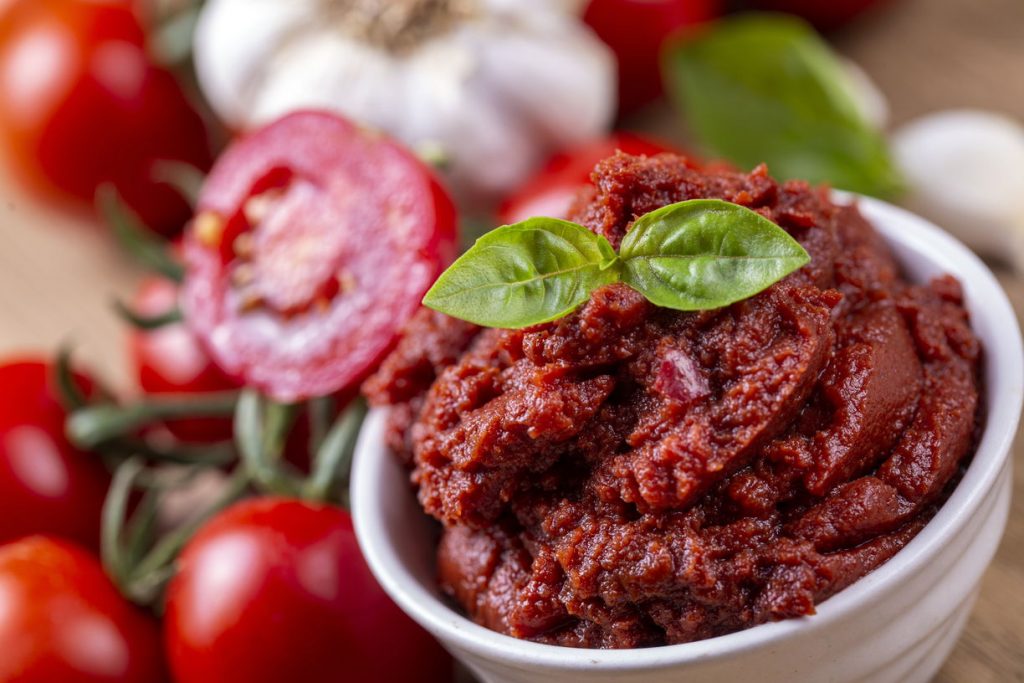
Though the tomato paste substitutes we’ve mentioned are equally rich and tasty, there’s nothing like the original ingredient’s thickening prowess.
Making tomato paste is incredibly easy but it takes a lot of time and effort. Moreover, you’ll be needing several pounds of tomatoes to make it worth your while. Pick ripe and meaty tomatoes and get started by following this guide.
Yields: 1 pint or 2 cups of tomato paste (32 servings)
Ingredients:
- 10 pounds of plum tomatoes (cored)
- 1 to 4 tablespoons of kosher salt (depends on preference)
- 1 tablespoon of extra-virgin olive oil
Preparation:
- Cut your plum tomatoes in half and remove the core or seeds. You can use your fingers to carefully remove only the unwanted seeds and not the flesh.
- Chop the tomatoes into small pieces and simmer the tomatoes on the stove for 30 minutes. Add olive oil and seasonings you prefer like basil.
- Run the cooked tomatoes through a food mill to get rid of the skin and remaining seeds. Return the milled tomatoes to the stove on high heat for 45 to 55 minutes. Stir occasionally and reduce heat as it thickens.
- At this point, what you have is essentially a tomato puree. You can cut through the prior steps by using a tomato puree if you like. For the reduction process, the best option to thicken and intensify the flavor of tomatoes is to use the oven. Spread the mixture evenly on a baking sheet.
- Pop the baking tray in an oven preheated to 200-degree F for 30 minutes. Afterward, stir the mixture to avoid creating a crust. Spread it evenly and return to the oven for around 3 hours. You’ll need to stir the mixture every 20 minutes and respread until it becomes thick and paste-like. As the moisture expels from the tomatoes, the amount of puree will decrease.
- Remove from the oven and let it cool to room temperature. Transfer the paste into a clean jar or airtight container. Press lightly to remove any air bubbles and top with more olive oil.
- After every use, make sure to level the mixture with a spoon and cover the surface with enough oil.
- You can also store homemade tomato paste in the freezer for up to nine months. You can use an ice cube tray or spread it flat in freezer-friendly containers.
Other Tomato-Free Substitutes for Thickening
Sometimes, some recipes only need a thickening agent and not the added depth of flavor from tomatoes. If that’s simply the case, you can use the following tomato paste-free substitutes to thicken your soups or sauces:
- Flour – This kitchen staple is actually a very common thickener. If you’ll be using flour to thicken a soup, pour it into a small bowl of water first. Mix vigorously using a fork to avoid the formation of lumps. Then, pour the mixture into your soup.
- It’s usually better to make a roux instead of adding flour on its own to thicken soups and sauces. Cooking the flour with fats like oil or butter helps remove the raw edge of the flour. Equal parts of fat and flour cooked until it’s lightly golden is the key to a perfect roux.
- Cornstarch – Like flour, carefully whisk together cornstarch and water first. It’s best to make a slurry before adding it to your dish so it incorporates better and avoids lumps. Pour the mixture into your soup and cook until viscous enough to your liking.
- Cream cheese – Cream cheese, in fact, is a natural thickener. It contains locust bean gum, a vegetable-based thickener. This substitute works best with cream-based soups or sauces. Some recipes may require you to use cream cheese to thicken said dishes.
READ ALSO: Can You Freeze Cream Cheese? Yes and Here’s How
Use These Tomato Paste Substitutes to Save Your Dishes
Now that you know the best alternatives for tomato paste, you never have to worry should you ever run out of stock. These tomato paste substitutes will give the right amount of tomato flavor, provided you use the proper ratio. So, elevate your eating experience with homemade tomato paste or its equally rich substitutes!



